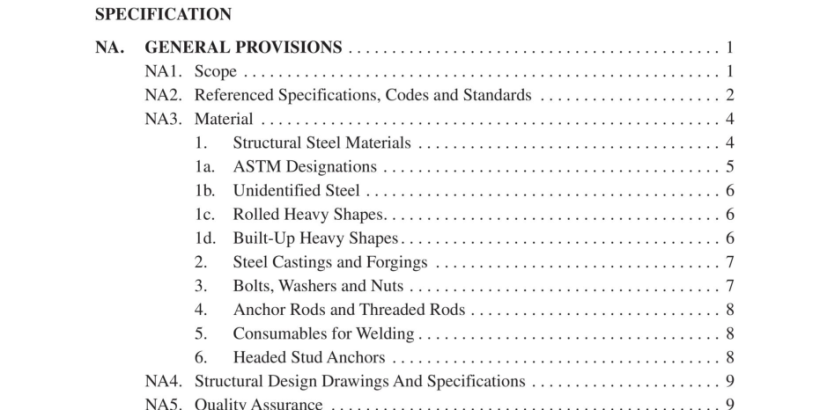ANSI AISC N690-12 pdf download
ANSI AISC N690-12 pdf download.Specification for Safety-Related Steel Structures for Nuclear Facilities
(1) In applying To and Ta, the thermal gradient and structural restraint effects shall be considered as appropriate.
(2) Where the structural effect of differential settlement is significant, it shall be included with the dead load.
(3) Where required, loads due to fluids with well-defined pressures shall be treated as dead loads, and loads due to lateral earth pressure, ground water pressure, or pressure of bulk materials shall be treated as live loads.
(4) If the dead load acts to stabilize the structure against the destabilizing effects of lateral force or uplift, the load factor on dead load shall be 0.90 of the assigned factor, and that on other gravity loads (L, Lr, S, C) shall be zero.
(5) If the OBE is not part of the design basis, Load Combination NB2-5 need not be evaluated.
(6) In Load Combinations NB2-8 and NB2-9, the maximum values of Pa, Ra, Ta, Yr, Yj and Ym, and including an appropriate dynamic load factor, shall be used unless a time-history analysis is performed to justify otherwise. In Load Com- bination NB2-9, the required strength criteria shall first be satisfied without Yr, Y; and Ym. In Load Combinations NB2-7 through NB2-9, when consider- ing concentrated loads Yj, Yr and Ym or tornado-borne missiles, local section strength may be exceeded, as per Section NB3.14, provided that there is no loss of function of any safety-related system.
(7) In addition to the abnormal loads, hydrodynamic loads resuling from a loss of coolant accident (LOCA) and/or safety relief valve actuation shall be appropri- ately considered for steel structure components subjected to these loads. Any fluid structure interaction associated with these hydrodynamic loads and those from the postulated seismic loads shall be taken into account.
Replace section with the following: Shop and erection drawings are permitted to be prepared in stages. Shop drawings shall be prepared in advance of fabrication and give complete information necessary for the fabrication of the component parts of the structure, including the location, type and size of welds and bolts. Erection drawings shall be prepared in advance of erec- tion and give information necessary for erection of the structure. Shop and erection drawings shall clearly distinguish between shop and field welds and bolts and shall clearly identify pretensioned and slip-critical high-strength bolted connections. Unless otherwise noted in the contract documents, a response to a request for infor- mation, as defined in Section 4.6 of the Code of Standard Practice, shall constitute design direction and a release for construction. Shop and erection drawings shall have a means of indicating which parts are safety-related.
15. Identification of Steel
The fabricator shall be able to demonstrate, by written procedure and by actual prac- tice, a method of material identification meeting the requirements of the contract documents. The material will be identified in one of the following ways as defined by the required use of the material. The material’s use must be defined by the contract documents. If the contract documents do not define the type of identification required, the identifi- cation defined in item (1) below will control.
(1) Material identified by grade and size only. Material need only be identified in such a manner that the purchaser is assured that the specified grade is used, and this documentation can be obtained throughout the service life of the structure.
(2) Material identified by heat number for the structure only. Material test reports shall be identifiable to the structure, but need not be to an individual member in the structure, in such a manner that the material test report can be obtained throughout the service life of the structure.
